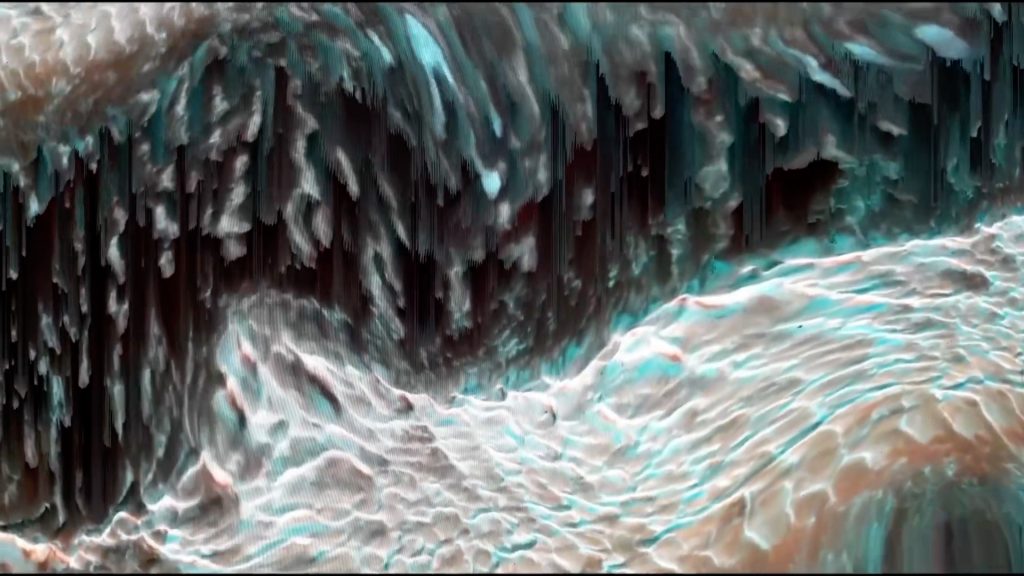Fact Resident Theresa Baumgartner translates the disruptive approach to sampling of Palestinian producer Muqata’a into evocative digital image manipulation.
Theresa Baumgartner met Palestinian underground hip-hop pioneer Muqata’a back in 2018, when she was filming on location in the city of Ramallah in the West Bank, Palestine. The DJ and producer has become legendary for his unique approach to sampling and looping, which he has developed into a practice which is at once musical and political. “When our land is being taken away, our culture is muted,” he told The Guardian around the time of the release of the documentary. “It’s a way to try and disrupt that – being a glitch in the system is very important. When your heritage is being attacked by the state, you have to find ways of being remembered, so I sample a lot.” Incorporating classical Arabic music, old records reclaimed from his grandparents’ collections and field recordings of Israeli military checkpoints into his compositions, Muqata’a fashions dense and detailed audio portraits of cultural and societal disruption, a project which is invoked by his moniker, which can be translated as “disruption,” “interference,” or “boycott.” It was the intricacy of Muqata’a’s method that initially drew Baumgartner to his music. “Muqata’a has a very special way of using field recordings,” she says, “there’s a lot of texture in his music.”


It’s this texture that Baumgartner zeroes in on for her visual treatment to the producer’s track ‘Quboor Mamila قُبور مَاميلا’, an opening salvo of sinister ambiance, skittering samples and frazzled noise that sets the scene for his new album for Hundebiss, Kamil Manqus كَامِل مَنْقوص. Drawing from her background in painting, Baumgartner layers digitally manipulated images into gauzy, textural vignettes that pulse and flicker to Muqata’s sounds. “I think of these visuals as paintings, but just with the added factor of time,” she explains. “Playing with colors and textures, that slow dripping movement. Older versions of the visuals actually stemmed from an obsession with deserts. On Google Maps I would fly over different deserts like the Gobi Desert and the Kalahari and it’s insanely beautiful what those satellite images spit out. With the photos being shot at different times of day, how the sun hits the surface changes, so there’s mistakes in the images. It’s gorgeous, it looks really weird.” Shreds of digital interference and pixelated feedback obscure the artist’s source material beyond recognition, meeting Muqata’a’s sonic disruption with her own audiovisual variant.


“I manipulate the footage in different ways,” continues Baumgartner. “The newer ones are partly the desert satellite images, as well as drone shots and footage ran through an old tube telly and then re-filmed. There’s a lot of procedure in it, it’s a bit like a ’70s special effects workshop, experimenting with analog stuff and seeing what happens.” Fusing a selection of these experiments together in a shifting sequence, the artist found inspiration from the structure of short story collections, specifically Olga Tokarczuk’s Flights. “These short little moments give you more of a hint to the story than just building the whole thing,” she says. “This works across different projects. You make something, but then the actual work happens in the head of the viewer – what people take from it, how people experience it and how it makes them feel. You make a proposition, throw something on the table, and then people take away from it what they want, or what they don’t want. It’s a way of talking to each other.” In this way, Baumgartner enacts an dialogue between two complementary art practices, the politicized patchwork of Muqata’a’s samples and loops drawing out the painterly energies of Baumgartner’s DIY visuals as the artist translates the producer’s aesthetics of disruption into evocative visual forms.


‘Quboor Mamila قُبور مَاميلا’ is taken from Kamil Manqus كَامِل مَنْقوص, which is out now on Hundebiss. You can follow Muqata’a on Instagram and visit his website.
For more information about Theresa Baumgartner and her work, you can visit her website and follow her on Instagram.
Watch next: Theresa Baumgartner Presents – Seaphony

































